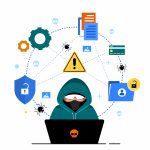As technology evolves, so do the risks associated with it. Emerging threats in IT are constantly changing, and businesses must stay ahead of the curve to protect their sensitive data and systems. Cybercriminals are becoming more sophisticated, making it crucial for organizations to be aware of the latest threats and take preventive measures to safeguard their IT infrastructure.
1. Understanding Emerging Threats in IT Security
Emerging threats in IT security are not just limited to traditional hacking attempts. These threats now include advanced persistent threats (APTs), ransomware, phishing attacks, and zero-day vulnerabilities. APTs involve long-term, targeted attacks aimed at stealing valuable information, while ransomware encrypts data and demands payment for its release. Businesses need to be aware of these sophisticated tactics and the damage they can cause.
2. The Rise of AI-Powered Attacks in Emerging IT Security
The use of artificial intelligence (AI) in cyberattacks has increased significantly in recent years. Emerging threats in IT now involve AI-powered malware, which can adapt and learn from its environment, making it more difficult to detect and mitigate. AI is also being used to create more convincing phishing emails and bypass traditional security measures. Businesses need to adopt advanced detection tools that can identify and respond to these AI-powered threats.
3. Protecting Against Emerging Threats in IT
To combat emerging threats in IT security, businesses must implement a multi-layered security approach. This includes regular software updates, employee training, and advanced threat detection systems. Additionally, companies should conduct regular security audits to identify potential vulnerabilities before they can be exploited by cybercriminals. Collaborating with IT security experts, like Bedots, can also provide essential insights and solutions for staying ahead of these threats.
4. Future Trends in Emerging IT Security Threats
As technology continues to advance, so will emerging threats in IT security. Quantum computing, for example, could potentially break current encryption methods, posing a massive risk to organizations worldwide. Businesses need to keep an eye on future trends and invest in forward-thinking security measures to prepare for these upcoming challenges.
Conclusion
Emerging threats in IT security pose significant risks to businesses of all sizes. By staying informed and adopting a proactive security strategy, organizations can protect themselves from the evolving tactics of cybercriminals. For expert advice and solutions, visit Bedots.
Read more: The Role of Artificial Intelligence in IT Security



